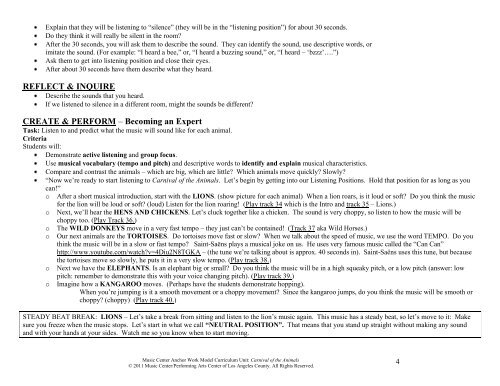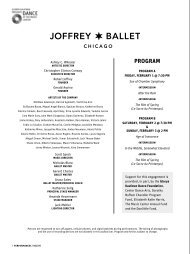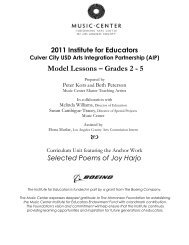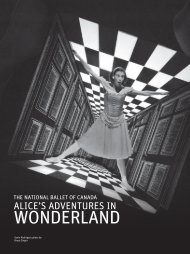Carnival of the Animals - Music Center
Carnival of the Animals - Music Center
Carnival of the Animals - Music Center
Create successful ePaper yourself
Turn your PDF publications into a flip-book with our unique Google optimized e-Paper software.
Explain that <strong>the</strong>y will be listening to “silence” (<strong>the</strong>y will be in <strong>the</strong> “listening position”) for about 30 seconds.<br />
Do <strong>the</strong>y think it will really be silent in <strong>the</strong> room?<br />
After <strong>the</strong> 30 seconds, you will ask <strong>the</strong>m to describe <strong>the</strong> sound. They can identify <strong>the</strong> sound, use descriptive words, or<br />
imitate <strong>the</strong> sound. (For example: “I heard a bee,” or, “I heard a buzzing sound,” or, “I heard – „bzzz‟….”)<br />
Ask <strong>the</strong>m to get into listening position and close <strong>the</strong>ir eyes.<br />
After about 30 seconds have <strong>the</strong>m describe what <strong>the</strong>y heard.<br />
REFLECT & INQUIRE<br />
Describe <strong>the</strong> sounds that you heard.<br />
If we listened to silence in a different room, might <strong>the</strong> sounds be different?<br />
CREATE & PERFORM – Becoming an Expert<br />
Task: Listen to and predict what <strong>the</strong> music will sound like for each animal.<br />
Criteria<br />
Students will:<br />
Demonstrate active listening and group focus.<br />
Use musical vocabulary (tempo and pitch) and descriptive words to identify and explain musical characteristics.<br />
Compare and contrast <strong>the</strong> animals – which are big, which are little? Which animals move quickly? Slowly?<br />
“Now we‟re ready to start listening to <strong>Carnival</strong> <strong>of</strong> <strong>the</strong> <strong>Animals</strong>. Let‟s begin by getting into our Listening Positions. Hold that position for as long as you<br />
can!”<br />
o After a short musical introduction, start with <strong>the</strong> LIONS. (show picture for each animal) When a lion roars, is it loud or s<strong>of</strong>t? Do you think <strong>the</strong> music<br />
for <strong>the</strong> lion will be loud or s<strong>of</strong>t? (loud) Listen for <strong>the</strong> lion roaring! (Play track 34 which is <strong>the</strong> Intro and track 35 – Lions.)<br />
o Next, we‟ll hear <strong>the</strong> HENS AND CHICKENS. Let‟s cluck toge<strong>the</strong>r like a chicken. The sound is very choppy, so listen to how <strong>the</strong> music will be<br />
choppy too. (Play Track 36.)<br />
o The WILD DONKEYS move in a very fast tempo – <strong>the</strong>y just can‟t be contained! (Track 37 aka Wild Horses.)<br />
o Our next animals are <strong>the</strong> TORTOISES. Do tortoises move fast or slow? When we talk about <strong>the</strong> speed <strong>of</strong> music, we use <strong>the</strong> word TEMPO. Do you<br />
think <strong>the</strong> music will be in a slow or fast tempo? Saint-Saëns plays a musical joke on us. He uses very famous music called <strong>the</strong> “Can Can”<br />
http://www.youtube.com/watch?v=4Diu2N8TGKA – (<strong>the</strong> tune we‟re talking about is approx. 40 seconds in). Saint-Saëns uses this tune, but because<br />
<strong>the</strong> tortoises move so slowly, he puts it in a very slow tempo. (Play track 38.)<br />
o Next we have <strong>the</strong> ELEPHANTS. Is an elephant big or small? Do you think <strong>the</strong> music will be in a high squeaky pitch, or a low pitch (answer: low<br />
pitch: remember to demonstrate this with your voice changing pitch). (Play track 39.)<br />
o Imagine how a KANGAROO moves. (Perhaps have <strong>the</strong> students demonstrate hopping).<br />
When you‟re jumping is it a smooth movement or a choppy movement? Since <strong>the</strong> kangaroo jumps, do you think <strong>the</strong> music will be smooth or<br />
choppy? (choppy) (Play track 40.)<br />
STEADY BEAT BREAK: LIONS – Let‟s take a break from sitting and listen to <strong>the</strong> lion‟s music again. This music has a steady beat, so let‟s move to it: Make<br />
sure you freeze when <strong>the</strong> music stops. Let‟s start in what we call ―NEUTRAL POSITION‖. That means that you stand up straight without making any sound<br />
and with your hands at your sides. Watch me so you know when to start moving.<br />
<strong>Music</strong> <strong>Center</strong> Anchor Work Model Curriculum Unit: <strong>Carnival</strong> <strong>of</strong> <strong>the</strong> <strong>Animals</strong><br />
© 2011 <strong>Music</strong> <strong>Center</strong>/Performing Arts <strong>Center</strong> <strong>of</strong> Los Angeles County. All Rights Reserved.<br />
4






